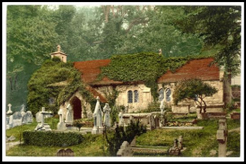St. Boniface

The Medieval Church of St. Boniface is one of the oldest churches on the Island. The original is reputed to have been founded by St. Boniface who stopped off at Bonchurch on his way to Germany in the 8th century. He is further reputed to have endeared himself to the local people by updating their methods of fishing.
The present church dates from about 1070. It is noted for its calm simplicity, set in peaceful and tranquil surroundings in this beautiful old village. As it became too small to meet the needs of the population in Victorian times, a fine, replacement was built in a cruciform shape in 1848, a little further up the hill.
This great apostle of Germany was born in Wessex, England, between the years 672 and 680. When he was small, some missionaries stayed a while at his home. They told the boy all about their work. They were so happy and excited about bringing the Good News to people. Boniface decided in his heart that he would be just like them when he grew up. While still young, he went to a monastery school to be educated. Some years later, he became a popular teacher. When he was ordained a priest, he was a powerful preacher because he was so full of enthusiasm.
Boniface wanted everyone to have the opportunity to know about and love Jesus and his Church. He became a missionary to the western part of Germany. Pope St. Gregory 11 blessed him and sent him on this mission. Boniface preached with great success. He was gentle and kind. He was also a man of great courage. Once, to prove that the pagan gods were false, he did a bold thing. There was a certain huge oak tree called the “oak of Thor.” The pagans believed it was sacred to their gods. In front of a large crowd, Boniface struck the tree a few times with an axe. The big tree crashed. The pagans realized their gods were false as nothing happened to Boniface.
Everywhere he preached, new members were received into the Church. In his lifetime, Boniface converted great numbers of people. In place of the statues of the pagan gods, he built churches and monasteries. In 732, the new pope, St. Gregory III made Boniface an archbishop and gave him another mission territory. It was Bavaria, which is part of Germany today. He and some companions went there to teach the people about the true faith. Here, too, the holy bishop was very successful.
It is reputed that on one of his journeys from Devon to Germany, he stopped briefly at Bonchurch, where he endeared himself to the local people by teaching them different fishing techniques. The first (wooden) church at Bonchurch (built in Saxon times) was named after Boniface. This was replaced by the present Medieval church, built around 1070.
In Germany, Boniface was preparing to confirm some converts. A group of fierce warriors swooped down on the camp. Boniface would not let his companions defend him. “Our Lord tells us to repay evil with good,” he said. “The day has come for which I have waited so long. Trust in God and he will save us.” The Barbarians attacked, and Boniface was the first one killed. He died a martyr on 5th June, 754. This date is now his feast day. He was buried at the famous monastery he had started at Fulda, Germany. This was what he wanted. Still today large numbers of people do not know the true God. We can pray for them. If God inspires us to become missionaries, we can ask St. Boniface to help us follow the call.